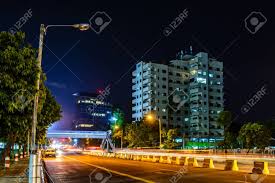 One day in October 2016 I arrived at Yangon‘s Mingaladon Int’l airport and took a taxi to my downtown destination. While driving down Pyay Road with its brightly illuminated, glittering facades, the high rises and the new flyovers, it crossed my mind how it was when I landed in Rangoon back in 1977. In those days there was one daily flight from Bangkok to Rangoon, operated by THAI and sometimes additional ones operated by Burma Airways. Today, dozens of international flights land and take off from Mingaladon every day. And even at night.
One day in October 2016 I arrived at Yangon‘s Mingaladon Int’l airport and took a taxi to my downtown destination. While driving down Pyay Road with its brightly illuminated, glittering facades, the high rises and the new flyovers, it crossed my mind how it was when I landed in Rangoon back in 1977. In those days there was one daily flight from Bangkok to Rangoon, operated by THAI and sometimes additional ones operated by Burma Airways. Today, dozens of international flights land and take off from Mingaladon every day. And even at night.
20. August 1977, 1930 hrs, Rangoon, Burma
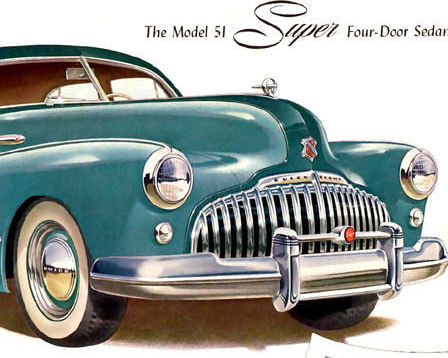 A light blue Buick Super 51 Sedan (built in 1946) dashes through Burma’s capital Rangoon with dim low beam lights. The old banger is rattling and squealing all over. But that doesn‘t seem to bother the driver at all. Just as little as the fact that the windows can be ratcheted only half way up and the rain is pouring in. The old boneshaker is on its way from the airport to downtown. It’s pissing heavily and it is pitch-dark. Sometimes, there’s a flashing on the roadside: a neon lamp, a candle or an electric bulb. Occasionally, a car is approaching or we’re splashing a passing rickshaw. Aboard are three hippies, among them the chronicler. And they wonder: Rangoon is supposed to be a city of two million people. However, since we’ve left the airport, we haven’t seen a single soul! What’s going on here? Where are the millions? The driver is an Indian who introduced himself as One Eyed Joe.
A light blue Buick Super 51 Sedan (built in 1946) dashes through Burma’s capital Rangoon with dim low beam lights. The old banger is rattling and squealing all over. But that doesn‘t seem to bother the driver at all. Just as little as the fact that the windows can be ratcheted only half way up and the rain is pouring in. The old boneshaker is on its way from the airport to downtown. It’s pissing heavily and it is pitch-dark. Sometimes, there’s a flashing on the roadside: a neon lamp, a candle or an electric bulb. Occasionally, a car is approaching or we’re splashing a passing rickshaw. Aboard are three hippies, among them the chronicler. And they wonder: Rangoon is supposed to be a city of two million people. However, since we’ve left the airport, we haven’t seen a single soul! What’s going on here? Where are the millions? The driver is an Indian who introduced himself as One Eyed Joe. 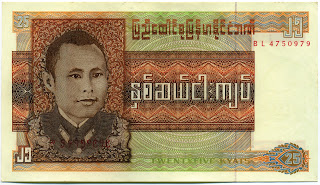 A fat, scruffy man. He’s wearing a sarong, flip flops and an undershirt soaked in sweat. And he is rather talkative. Since we boarded his sorry transport he’s trying to talk us into selling our treasures to him at a bargain price: three bottles of Johnny Walker Red Label and three cartons of Triple Five cigarettes. We fob him off with a knowing smile – we‘ve heard about this scam before. Tomorrow we’ll get twice as much for it! Besides, we do have Burmese money! In Penang we’ve bought some from an Indian money changer at a rate of 20 Kyat for one dollar. Three times the official rate!
A fat, scruffy man. He’s wearing a sarong, flip flops and an undershirt soaked in sweat. And he is rather talkative. Since we boarded his sorry transport he’s trying to talk us into selling our treasures to him at a bargain price: three bottles of Johnny Walker Red Label and three cartons of Triple Five cigarettes. We fob him off with a knowing smile – we‘ve heard about this scam before. Tomorrow we’ll get twice as much for it! Besides, we do have Burmese money! In Penang we’ve bought some from an Indian money changer at a rate of 20 Kyat for one dollar. Three times the official rate!
Finally we arrive at the Thamada-Hotel, among the best of the seven hotels that have a licence to accommodate foreigners. We found it a little run-down! Later we realized that it had been the highlight of our trip! We were about to see much worse … We submitted our passports and money forms and checked in. Our rooms were modest – but with air condition. Rangoon’s dining scene was quite straightforward: besides the hotel restaurants there were only two more that were considered ‚safe‘ by the small expat community: Red Ruby in Bo Aung Kyaw Street and Burma Kitchen in Shwegondine Road. Both have survived to this very day. The first one under its old name, the other has been converted into a Japanese restaurant (Furusato) a long time ago. So we chose the hotel’s restaurant, located at first floor. It was here that I first saw the menu that was identical in all government hotels in Myanmar. It would become a trusted companion during my travels in Burma. Rangoon was the only place where one could get lobster thermidor, even though it was mentioned in every city. The waiter was surprisingly well-dressed: he wore black trousers, his cleanest dirty white shirt and a bow tie. Noblesse oblige! In an ambience that reminded me of East Germany. He was even sporting a pair of black shoes! He served our dinner in the most professional way. I was especially impressed by the way he balanced the peas from the platter onto my plate. For a long time I couldn‘t help but feel that Burma was some kind of tropical East Germany. And I loved it! After dinner we went back to our rooms and while in bed, I reviewed the events of the day. And quite a day it had been!
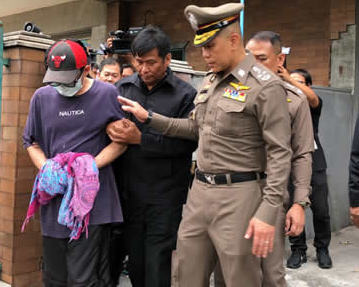 It started at dawn after a short but lively night. I was just lying in bed with in my room at the ATLANTA hotel with my little Thai girl friend named Nit, when suddenly someone knocked violently at my door: ‘Open up! Police!‘. If I would have worn boots, my heart would certainly have been in there. I wrapped one of the worn out Atlanta towels around my hips and opened the door. Two Thai coppers stood in front of me, pushed me aside and entered the room. They ignored the girl that was sitting fearfully on the backboard of the bed, the blanket up to her nose. They lifted the mattress and saw the traveler’s checks I had reported stolen the day before. In my mind’s eye I saw myself in jail, the notorious Bangkok Hilton (see photo). To my relief, they lowered the mattress without saying a word. Then they searched my luggage: a backpack and a crocodile-leather attaché that my friend Robert Weide had given me as a pawn for 70 DM he had borrowed from me the night before. They looked around the room and took their leave. Only a drug bust! Lucky me! After getting away with the fright we laid down again and cuddled a bit. At 9 a.m. we went down for breakfast. There we met Robert Weide who was supposed to give me back my money. As could be expected he hadn‘t been able to procure it. Thus I became the owner of his case that matched quite well with my US Army rucksack. A few weeks later I swapped it in Delhi for a big bag filled with crocheted cotton lamps. They laid the base for my ensuing business career that led me from Berlin’s flea market to a shop on Berlin’s fashionable Ku’damm all the way to another one in the Zoo Palast cinema, venue of the famous Berlinale film festival.
It started at dawn after a short but lively night. I was just lying in bed with in my room at the ATLANTA hotel with my little Thai girl friend named Nit, when suddenly someone knocked violently at my door: ‘Open up! Police!‘. If I would have worn boots, my heart would certainly have been in there. I wrapped one of the worn out Atlanta towels around my hips and opened the door. Two Thai coppers stood in front of me, pushed me aside and entered the room. They ignored the girl that was sitting fearfully on the backboard of the bed, the blanket up to her nose. They lifted the mattress and saw the traveler’s checks I had reported stolen the day before. In my mind’s eye I saw myself in jail, the notorious Bangkok Hilton (see photo). To my relief, they lowered the mattress without saying a word. Then they searched my luggage: a backpack and a crocodile-leather attaché that my friend Robert Weide had given me as a pawn for 70 DM he had borrowed from me the night before. They looked around the room and took their leave. Only a drug bust! Lucky me! After getting away with the fright we laid down again and cuddled a bit. At 9 a.m. we went down for breakfast. There we met Robert Weide who was supposed to give me back my money. As could be expected he hadn‘t been able to procure it. Thus I became the owner of his case that matched quite well with my US Army rucksack. A few weeks later I swapped it in Delhi for a big bag filled with crocheted cotton lamps. They laid the base for my ensuing business career that led me from Berlin’s flea market to a shop on Berlin’s fashionable Ku’damm all the way to another one in the Zoo Palast cinema, venue of the famous Berlinale film festival.

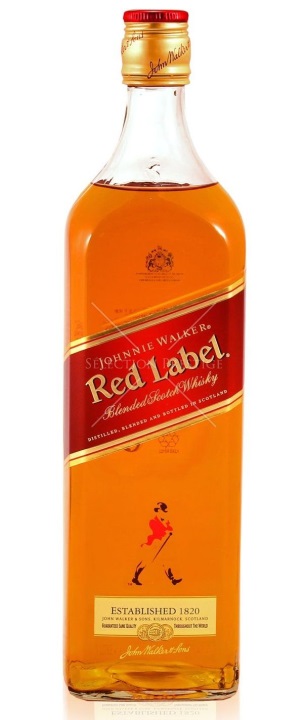 Our flight to Rangoon was scheduled for late afternoon. So we spent the time at the hotel’s swimming pool. Then we boarded public air con bus no. 11 to Bangkok’s Don Mueang airport. We (my friend Yves, a Belgian guy named Philippe and myself) had booked a Burma Airways flight from Bangkok to Kathmandu with stopover in Rangoon. We had heard about the whisky-and-cigarette business from other travelers. So every one of us bought a bottle of Johnny Walker Red Label and a carton of 555-cigarettes. So far unbeknownst to me but it seemed to be extremely popular in Burma. According to rumours, one could finance a complete week in Burma from the proceeds. Except for hotels and flight tickets – needless to say. Burma Airways‘ plane did not exactly inspire confidence: an old Fokker Friendship, merely capable of transporting 52 passengers. When we tried to store our hand luggage in the overhead compartments we were in for a surprise: no space! All were filled up to the rim with Johnny Walker and 555-cartons. The pretty attractive stewardess asked us to store our things under the seat.
Our flight to Rangoon was scheduled for late afternoon. So we spent the time at the hotel’s swimming pool. Then we boarded public air con bus no. 11 to Bangkok’s Don Mueang airport. We (my friend Yves, a Belgian guy named Philippe and myself) had booked a Burma Airways flight from Bangkok to Kathmandu with stopover in Rangoon. We had heard about the whisky-and-cigarette business from other travelers. So every one of us bought a bottle of Johnny Walker Red Label and a carton of 555-cigarettes. So far unbeknownst to me but it seemed to be extremely popular in Burma. According to rumours, one could finance a complete week in Burma from the proceeds. Except for hotels and flight tickets – needless to say. Burma Airways‘ plane did not exactly inspire confidence: an old Fokker Friendship, merely capable of transporting 52 passengers. When we tried to store our hand luggage in the overhead compartments we were in for a surprise: no space! All were filled up to the rim with Johnny Walker and 555-cartons. The pretty attractive stewardess asked us to store our things under the seat. 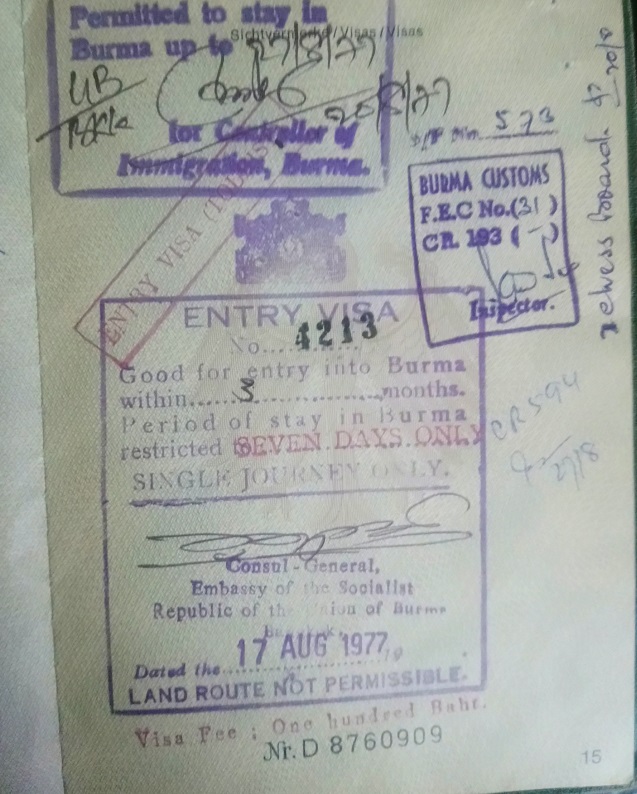 And who would turn down a pretty lady’s request? Especially, as it was only a short flight, a little more than one hour. They even offered a meal: every passenger got a white box. When I opened it, a big cockroach walked out of it. Hard to believe, but true. However, the cake was wrapped in plastic and so I ate it. The orange was o.k. as well. When we arrived, it rained heavily. Workers holding umbrellas escorted us to the immigration counter. The airport was rather small and we were processed quite quickly. The most difficult thing was the completion of the ‚form‘. We had to register all foreign currency in our possession.
And who would turn down a pretty lady’s request? Especially, as it was only a short flight, a little more than one hour. They even offered a meal: every passenger got a white box. When I opened it, a big cockroach walked out of it. Hard to believe, but true. However, the cake was wrapped in plastic and so I ate it. The orange was o.k. as well. When we arrived, it rained heavily. Workers holding umbrellas escorted us to the immigration counter. The airport was rather small and we were processed quite quickly. The most difficult thing was the completion of the ‚form‘. We had to register all foreign currency in our possession.
These could be converted into the national currency. Everything transaction had to be made in Kyat. Whenever we spend money (tickets, hotels), we had to enter it in this form. If one didn’t have enough money on his form, he had to change money again. Rather complicated and in reminded me of East Germany. In fact, there were quite a few parallels with the communist state. But contrary to the GDR the people here were of overwhelming friendliness. When we stepped out of the arrival hall we were overrun by hordes of touts and taxi drivers who wanted to take us to our hotel at completely exaggerated prices. Hey, find yourself another fool! We bargained One-Eyed-Joe down to one dollar and off we went!
Before our first visit to Burma we had hardly any idea about where we were going. Those days the country was even more unknown, than it is today. 20.000 visitors (and I guess only a fraction of them tourists) visited the country in 1977. Probably, many potential tourists were put off by the fact that they were allowed to stay for only one week. For us it was o.k., as it was just a stopover on our way from Bangkok to Kathmandu. Little did I know that this week was about to change my life forever. My friend Yves and I had covered about half the distance of our great trip from Bali to Sri Lanka (most of it overland). In Penang we considered for the first time to make a stopover in Burma.
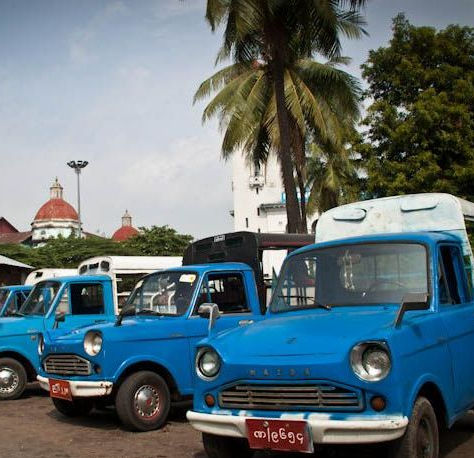 The next morning we took a stroll through Rangoon’s downtown. We got rid of our goodies in no time: 300 % profit, not bad! These items were truly status symbols! We saw them in many places next to family photos and bric-a-brac. When the bottle was empty, it was refilled with tea in order to keep up the good impression. They were also used as semi-official measure of capacity, e. g. for gasoline. In some places they are still in use. One Eyed Joe had told us that May Hla Mu pagoda in Myauk Okkalapa was an absolute must for every tourist. A highlight, if there ever was one! Good for his wallet, too. It felt like a jungle excursion. In the afternoon we toured Shwedagon pagoda in the rain.
The next morning we took a stroll through Rangoon’s downtown. We got rid of our goodies in no time: 300 % profit, not bad! These items were truly status symbols! We saw them in many places next to family photos and bric-a-brac. When the bottle was empty, it was refilled with tea in order to keep up the good impression. They were also used as semi-official measure of capacity, e. g. for gasoline. In some places they are still in use. One Eyed Joe had told us that May Hla Mu pagoda in Myauk Okkalapa was an absolute must for every tourist. A highlight, if there ever was one! Good for his wallet, too. It felt like a jungle excursion. In the afternoon we toured Shwedagon pagoda in the rain. 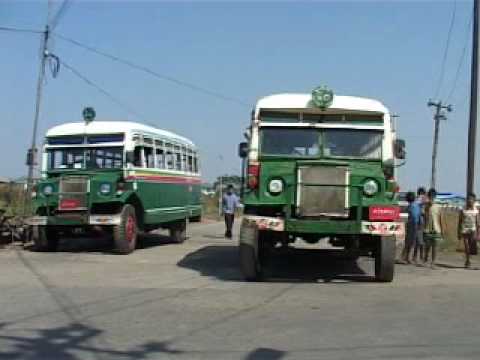 There were hardly any cars on the city’s wide roads. The few we saw were either old U.S. street cruisers or British Austin limousines. Plus a few locally made cars. The blue ones had four wheels and resembled East German Trabant cars. Then there were three wheelers that looked like a 1950’s Borgward Goliath. To our surprise we saw no motor bikes or even bicycles. Later we were told that those were banned in Rangoon. The buses were a real gas! Bedfords and Chevrolets from the 1930‘s! We could not read their destinations as it was all in pretzel script. And the weirdest thing: the passengers were traveling in these vintage cars as if it was most normal thing in the world! Until then I‘d had considered them more like a fairground attraction.
There were hardly any cars on the city’s wide roads. The few we saw were either old U.S. street cruisers or British Austin limousines. Plus a few locally made cars. The blue ones had four wheels and resembled East German Trabant cars. Then there were three wheelers that looked like a 1950’s Borgward Goliath. To our surprise we saw no motor bikes or even bicycles. Later we were told that those were banned in Rangoon. The buses were a real gas! Bedfords and Chevrolets from the 1930‘s! We could not read their destinations as it was all in pretzel script. And the weirdest thing: the passengers were traveling in these vintage cars as if it was most normal thing in the world! Until then I‘d had considered them more like a fairground attraction.
In the evening we paid a visit to Tourist Burma at Sule pagoda and bought tickets for the train Mandalay the next day. We concluded the first day in Rangoon with a stroll through the alleys near Sule. It was a magical atmosphere: teenagers were sitting in the streets and sang with guitar accompaniment. When we walked past they give us a big hello and an even bigger smile. It seemed that foreigners were a curiosity here in Rangoon! And still no cars in sight! Ground floor dwellers were sitting in their flats that had no walls to the street but only shutters. So we had a chance to see how the people in Rangoon lived. And suddenly we saw cars – they were parked inside the flats! We’d been wondering for quite some time why there were ramps leading from the streets into the flats. As it seemed, cars represented an enormous value in Burma and had to be protected against thieves at any cost. And so the people were sitting behind their shutters by the lights of their neon lamps and their candles, listened to the radio, chatted – or maybe admired their cars. Television didn’t exist in Burma those days. It was introduced only ten years after my first visit. It was obvious that the people of Rangoon had an urgent need for security. Not only ground-floor flats were secured with iron shutters. Everybody can see the need of this. But even windows in the third floor were heavily secured with window grilles. And this hasn’t changed in more than forty years! Burma seemed to be a dangerous place…
The train to Mandalay departed at 6 a.m. Rangoon’s central railway station looked like it was time-warped from the 1930’s. It was dark and people were lying on the platforms, many of them wrapped in blankets. We were not sure if they were waiting for their train or had no place to stay. I had entrusted my attache case to the hotel’s store room. It came as a bit of a disappointment when the train was dragged into the station by a diesel engine. I’d have preferred (and expected!) a steam engine. Wide swathes of countryside were submerged in water. In some places the track was invisible for miles. But the engine driver seemed to know his way! And it was great fun! We arrived in Mandalay at around ten p.m. Much to our surprise, we were ‘welcomed’ – by the staff of ‘Toyota-Express’. These people organized trips for hippies in Upper Burma. Up to ten passengers were squeezed into the back of a Toyota pickup truck, their luggage on the roof. Only sissies would pay more for the right to sit in the driver’s cab. Mandalay-Bagan-Inle-Mandalay in four days. Definitely not for the faint-hearted. And absolutely not recommended! Instead, we followed a tout to a dump called Mann Shwe Myo (Mandalay Golden City).
 On the next day we went sightseeing and saw the usual attractions. Mandalay Hill with the giant guardian lions made a lasting impression. If I’m not mistaken, we paid a visit to the Mahamuni-Buddha, too. But I don’t remember it. Our favourite was the Irrawaddy river side. There was a pile village in front of the levee and it was teeming with life. The absolute highlight was a place called Kywe Zun where gangs of water buffalos pulled heavy teak logs out of the river and up the levee. Some old lorries were in action, too. If they couldn’t make it up the levee on their own, a few water buffalos were harnessed with yokes and iron chains and they made all the difference. A remarkable sight were the children on the levee. Very friendly and whenever they saw a foreigner they made the V-sign with their fingers and shouted ,peace, peace’. No idea what that meant. Most probably it had been introduced by some hippies…
On the next day we went sightseeing and saw the usual attractions. Mandalay Hill with the giant guardian lions made a lasting impression. If I’m not mistaken, we paid a visit to the Mahamuni-Buddha, too. But I don’t remember it. Our favourite was the Irrawaddy river side. There was a pile village in front of the levee and it was teeming with life. The absolute highlight was a place called Kywe Zun where gangs of water buffalos pulled heavy teak logs out of the river and up the levee. Some old lorries were in action, too. If they couldn’t make it up the levee on their own, a few water buffalos were harnessed with yokes and iron chains and they made all the difference. A remarkable sight were the children on the levee. Very friendly and whenever they saw a foreigner they made the V-sign with their fingers and shouted ,peace, peace’. No idea what that meant. Most probably it had been introduced by some hippies…
From Mandalay we flew to Bagan. We stayed at the Moe Moe guest house – only three dollars. Two years before our visit, a devastating earthquake had struck the plain of Bagan. The ancient city looked like a giant construction site. A rather imposing one! With some luck and skill and a little tea money we managed to get flight tickets from Bagan to Rangoon. I was totally fascinated by Burma and I vowed to myself that this was not my last visit to Burma. But little did I know that I would be back in less than three months…
Axel Bruns
